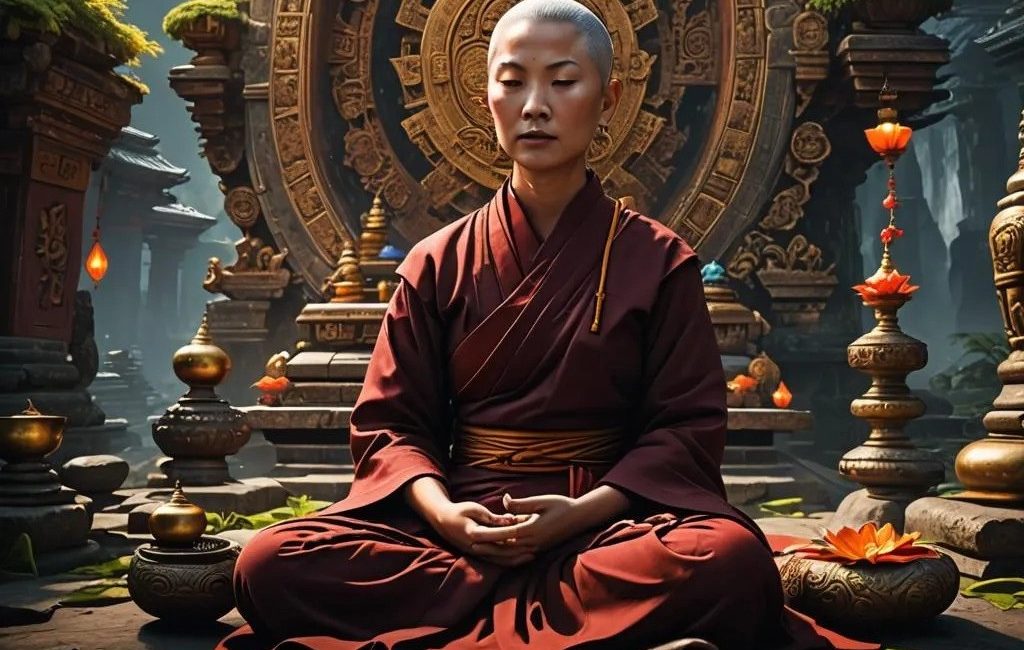In his 2022 spring teaching of Arya Kshema teachings, the 17th Karmapa presented the historical point that the full ordination of women (bhikshunis) has always been an option presented in the Mulasarvastivada Vinaya (MSV), the body of Buddhist law followed by the Vajrayana schools since Tibet’s first diffusion. The Karmapa’s consistent voice for the full ordination of women was based on not only a moral position as the Karma Kagyu’s leader in the 21st century, but also on a striking historical fact: that there are records of many locations in Tibet with ordained bhiksunis.
Adele Tomlin of Dakini Translations has pointed out that historically, the Gelug school’s political triumph over the Kagyu school eventuated in many significant historical consequences, with the disappearance of bhikhsunis in Tibet being one of the very likely results (and correspondingly, across the Himalayan region that now spans multiple countries).
The present Dalai Lama, one of the Gelug’s most prominent leaders, said many years ago that the bhiksuni ordination never took root in Tibet, based on the understanding that the bhikshuni ordination lineage never went to the region (that is, there were no fully ordained nuns in the Tibetan Empire during the first diffusion). Adele Tomlin’s recent research, along with the past history unearthed by the Karmapa, was groundbreaking and reframed the grounds on which bhikshuni ordination might be revived.
In the Vajrayana sphere of monastic communities, an extensive, intensive, multi-faceted effort of over three decades has come to fruition through rapid progress in three respects, which are tied directly to the “three trainings”:
Sila (with full gelongma/bhiksuni higher ordinations of women in the Mulasarvastivada Vinaya),
Samadhi (subsequent intensive, multi-year trainings and long retreats in togdenma: these are monastic yogis trained in traditional long intensive retreats), and:
Prajna (accompanying monastic education in philosophy and certifications like the Geshema degree, which is equivalent to the Geshe degrees of monks).
In a 2020 seminal study that was funded by the Deutsche Forschungsgemeinschaft (German Research Foundation), Carola Roloff presented a case for how bhikshuni ordination, which has been absent for centuries in Vajrayana, could be legitimately reinstated. This study, which brought together over 20 years of research, provided a crucial academic basis for Bhutan’s decision to move ahead with the institutional restoration of the Vajrayana bhikshuni lineage, fully and completely according to MSV sanctions. The historic ordination ceremony took place on 21 June 2022.
As the world’s last remaining constitutional Buddhist monarchy, Bhutan was uniquely placed to initiate this historic event. Unlike Bhutan’s Drukpa Kagyu, the majority of Vajrayana schools have heads and leaders, but are not tied to an explicit church-state (sangha-state) relationship. When the Je Khenpo (National Master) of Bhutan had to make the decision, he was taking into account the request of the Queen Mother, as well as that of the king and queen. I am told that since the reigning king and queen wield significant influence in Bhutan, the Je Khenpo felt that he could and should move forward, without needing to get everyone else’s outside agreement—even from other Vajrayana heads.
This has meant that the institutional MSV Bhikshuni Sangha exists once more, with members empowered to ordain women according to its canon law, and is going strong into its second year in 2024. This is a great privilege to witness in this lifetime.
The Bhutan Nuns Foundation Office was going to organize the country’s 2nd Bhikshuni Ordination, originally scheduled for 21 June 2024. It received an overwhelming response from registering Buddhist nuns worldwide but “due to unforeseen circumstances,” as mentioned on the foundation’s Facebook page, the ordination ceremony is to be rescheduled according to the Je Khenpo’s instructions.
Geshemas are authorized teachers (the popular comparison is that of the geshe/geshema certificate to a Western-style PhD). This number continues to grow, and there is anecdotal evidence that the number khenmos (authorized female masters that often double as nunnery abbesses) is growing. This is still not common and is only newly happening. They have been very rare and normally Himalayan nunneries have a khenpo, or male master.
In 2023, the Drikung Kagyu lineage’s Vajra Dakini Nunnery, under the leadership of co-head Drikung Kyabgön Chetsang Rinpoche, hosted a historic international bhikshuni varsa in Sravasti, India. Although there are multiple known ruins of the ancient bhikshuni sangha in Sravasti, traces of female monastic practice had disappeared for centuries. This was a kind of homecoming, after hundreds of years of absence.
Just as there are four pillars of the global sangha as a whole, four pillars uphold the contemporary bhikshuni sangha: gelongma (bhikshunis), togdenma (yogi adepts), geshemas (academic scholars), and khenmo (abbesses or institutional leaders). The foundations of the resurrection of the bhikshuni sangha are stable, solid, and completely legitimate. The movement for the 21st century’s spread of ordained women can bring about the potential to bring for the kind of positive change that has been yearned for for decades in the modern period.
Reference
Carola Roloff. 2020. The Buddhist Nuns’ Ordination in the Tibetan Canon: Possibilities of the Revival of the Mulasarvastivada Bhiksuni Lineage. Hamburg: Projekt Verlag.
See more
‘LIKE STARS IN THE DAY’, THE DESCENT OF FEMALE ARHATIS: FULLY ORDAINED TIBETAN BUDDHIST NUNS IN TIBET, PAST, PRESENT AND FUTURE (17th Karmapa Spring Teachings (Day 13) (Dakini Translations)
Related news from BDG
142 Buddhist Nuns Receive Full Ordination at Landmark Ceremony in Bhutan
Related blog posts from BDG
Ongoing progress in the full monastic ordination of women: Theravada
Summer Solstice Milestone: Bhutanese Nuns receive the Gelongma Vows


